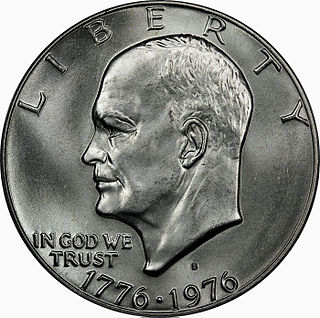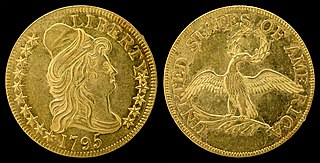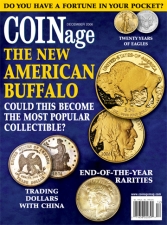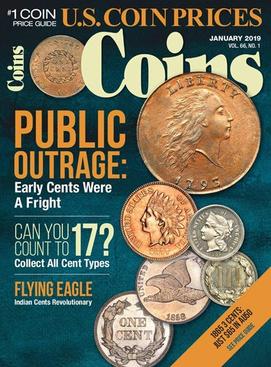Related Research Articles

Coin collecting is the collecting of coins or other forms of minted legal tender. Coins of interest to collectors include beautiful, rare, and historically significant pieces. Collectors may be interested, for example, in complete sets of a particular design or denomination, coins that were in circulation for only a brief time, or coins with errors. Coin collecting can be differentiated from numismatics, in that the latter is the systematic study of currency as a whole, though the two disciplines are closely interlinked.
Coins of the United States dollar, aside from those of the earlier Continental currency were first minted in 1792. New coins have been produced annually and they make up a valuable aspect of the United States currency system. Circulating coins exist in denominations of 1¢, 5¢, 10¢, 25¢, 50¢, and $1.00. Also minted are bullion, including gold, silver and platinum, and commemorative coins. All of these are produced by the United States Mint. The coins are then sold to Federal Reserve Banks which in turn are responsible for putting coins into circulation and withdrawing them as demanded by the country's economy.

The United States Mint is a bureau of the Department of the Treasury responsible for producing coinage for the United States to conduct its trade and commerce, as well as controlling the movement of bullion. The U.S. Mint is one of two U.S. agencies that produce money in the case of minting coinage; the other is the Bureau of Engraving and Printing, which prints paper currency. The first United States Mint was created in Philadelphia in 1792, and soon joined by other centers, whose coins were identified by their own mint marks. There are currently four active coin-producing mints: Philadelphia, Denver, San Francisco, and West Point.

A double eagle is a gold coin of the United States with a denomination of $20. The coins are 34 mm × 2 mm and are made from a 90% gold and 10% copper alloy and have a total weight of 1.0750 troy ounces.

Bullion is non-ferrous metal that has been refined to a high standard of elemental purity. The term is ordinarily applied to bulk metal used in the production of coins and especially to precious metals such as gold and silver. It comes from the Anglo-Norman term for a melting-house where metal was refined, and earlier from French bouillon, "boiling". Although precious metal bullion is no longer used to make coins for general circulation, it continues to be held as an investment with a reputation for stability in periods of economic uncertainty. To assess the purity of gold bullion, the centuries-old technique of fire assay is still employed, together with modern spectroscopic instrumentation, to accurately determine its quality.

The eagle was a United States $10 gold coin issued by the United States Mint from 1795 to 1933.

The Franklin half dollar is a coin that was struck by the United States Mint from 1948 to 1963. The fifty-cent piece pictures Founding Father Benjamin Franklin on the obverse and the Liberty Bell on the reverse. A small eagle was placed to the right of the bell to fulfill the legal requirement that half dollars depict the figure of an eagle. Produced in 90 percent silver with a reeded edge, the coin was struck at the Philadelphia, Denver, and San Francisco mints.

The United States Bicentennial coinage is a set of circulating commemorative coins, consisting of a quarter, half dollar and dollar struck by the United States Mint in 1975 and 1976. Regardless of when struck, each coin bears the double date 1776–1976 on the normal obverses for the Washington quarter, Kennedy half dollar and Eisenhower dollar. No coins dated 1975 of any of the three denominations were minted.

The American Silver Eagle is the official silver bullion coin of the United States.

The West Point Mint is a U.S. Mint production and depository facility erected in 1937 near the U.S. Military Academy in West Point, New York, United States. As of 2019 the mint holds 22% of the United States' gold reserves, or approximately 54,000,000 troy ounces (1,700,000 kg). The mint at West Point is second only to the gold reserves held in secure storage at Fort Knox. Originally, the West Point Mint was called the West Point Bullion Depository. At one point it had the highest concentration of silver of any U.S. mint facility, and for 12 years produced circulating Lincoln cents. It has since minted mostly commemorative coins and stored gold.

The half eagle is a United States coin that was produced for circulation from 1795 to 1929 and in commemorative and bullion coins since 1983. Composed almost entirely of gold, its face value of five dollars is half that of the eagle coin. Production of the half eagle was authorized by the Coinage Act of 1792, and it was the first gold coin minted by the United States.

The gold dollar or gold one-dollar piece is a gold coin that was struck as a regular issue by the United States Bureau of the Mint from 1849 to 1889. The coin had three types over its lifetime, all designed by Mint Chief Engraver James B. Longacre. The Type 1 issue has the smallest diameter of any United States coin minted to date.

COINage, a bi-monthly American special-interest magazine, targeting numismatists and coin investors. Behn-Miller Publications, Inc. - under the joint ownership of Gordon Behn and COINage editorial director James L. Miller - originally published the magazine on a quarterly basis. During that period it was based in Dallas, Texas. In 1965 the magazine moved to a bi-monthly publishing schedule, before moving to a monthly publishing schedule from 1966 until 2019.

Joseph Farran Zerbe was an American coin collector and dealer who was the president of the American Numismatic Association (ANA) in 1908 and 1909. He served as chief numismatist at the World's Fairs in St. Louis (1904), Portland (1905), and San Francisco (1915).

The Indian Head gold pieces or Pratt-Bigelow gold coins were two separate coin series, identical in design, struck by the United States Mint: a two-and-a-half-dollar piece, or quarter eagle, and a five-dollar coin, or half eagle. The quarter eagle was struck from 1908 to 1915 and from 1925–1929. The half eagle was struck from 1908 to 1916, and in 1929. The pieces remain the only US circulating coins with recessed designs. These coins were the last of their denominations to be struck for circulation, ending series that began in the 1790s.

The Lewis and Clark Exposition Gold dollar is a commemorative coin that was struck in 1904 and 1905 as part of the United States government's participation in the Lewis and Clark Centennial Exposition, held in the latter year in Portland, Oregon. Designed by United States Bureau of the Mint Chief Engraver Charles E. Barber, the coin did not sell well and less than a tenth of the authorized mintage of 250,000 was issued.

A gold coin is a coin that is made mostly or entirely of gold. Most gold coins minted since 1800 are 90–92% gold (22‑karat), while most of today's gold bullion coins are pure gold, such as the Britannia, Canadian Maple Leaf, and American Buffalo. Alloyed gold coins, like the American Gold Eagle and South African Krugerrand, are typically 91.7% gold by weight, with the remainder being silver and copper.

The Louisiana Purchase Exposition gold dollar is a commemorative coin issue dated 1903. Struck in two varieties, the coins were designed by United States Bureau of the Mint Chief Engraver Charles E. Barber. The pieces were issued to commemorate the Louisiana Purchase Exposition held in 1904 in St. Louis; one variety depicted former president Thomas Jefferson, and the other, the recently assassinated president William McKinley. Although not the first American commemorative coins, they were the first in gold.

The Liberty Head double eagle or Coronet double eagle is an American twenty-dollar gold piece struck as a pattern coin in 1849, and for commerce from 1850 to 1907. It was designed by Mint of the United States Chief Engraver James B. Longacre.

Coins was an American monthly numismatic publication.
References
- ↑ Smith, Pete. "Michael Ray Fuljenz". nnp.wustl.edu. EPNNES & Washington University in St. Louis. Retrieved 18 January 2024.
- ↑ Barras, AnaClare. "Lake Charles native honored with coin-collecting award". kplctv.com. Gray Media Group, Inc. Retrieved 18 January 2024.
- ↑ "Our Expert's Resume". universalcoin.com. Universal Coin & Bullion, Ltd. Retrieved 18 January 2024.
- ↑ "COINage Confidential: Michael Ray Fuljenz". coinagemag.com. COINage Magazine (Beckett Media). Retrieved 18 January 2024.
- ↑ "Mike Fuljenz to Receive Chester L. Krause Memorial Distinguished Service Award". numismaticnews.net. Active Interest Media. Retrieved 19 January 2024.
- ↑ "Mike Fuljenz". coinworld.com. Amos Media Company. Retrieved 19 January 2024.
- ↑ "Fuljenz and Jordan Win National Awards for Investigations of Traveling Gold Buyers". 13 August 2010.